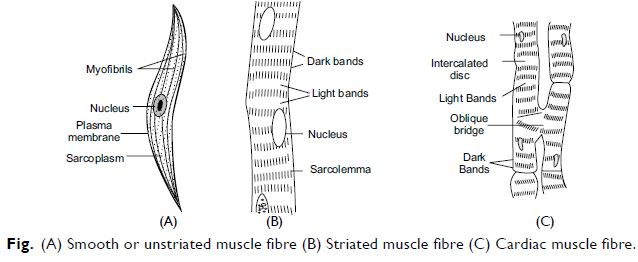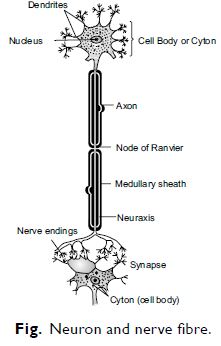Question 1:
What is a tissue?
Answer:
A group of cells that are similar in structure and perform a particular function is called a tissue.
Question 2:
What is the utility of tissues in multi-cellular organisms?
Answer:
(a) Different types of tissues are specialised to perform specific functions.
(b) Tissues bring about division of labour and increase efficiency.
Question 3:
Name types of simple tissues.
Answer:
Three types of simple tissues found in plants are parenchyma, collenchyma and sclerenchyma.
Question 4:
Where is apical meristem found?
Answer:
Apical meristem is present at the growing tips of roots, stem and stem branches of plants.
Question 5:
Which tissue makes up the husk of coconut?
Answer:
It is formed of sclerenchyma tissue.
Question 6:
What are constituents of phloem?
Answer:
Phloem tissue is made up of four types of elements: sieve tube cells, companion cells, phloem fibres and phloem parenchyma.
Question 7:
Name the tissue responsible for the movement of our body.
Answer:
Muscular tissue
Question 8:
What does a neuron look like?
Answer:
A neuron consists of cell body called the cyton with hair-like parts called dendrites and a long axon.
Question 9:
Give three features of cardiac muscles.
Answer:
(a) Cardiac muscles are cylindrical, branched and uninucleate.
(b) They are interconnected by oblique bridges.
(c) Their ends are flat and zig-zag, called intercalated discs.
Question 10:
What are functions of areolar tissue?
Answer:
Areolar tissue fills the space between the organs, acts as a packing tissue, supports internal organs and helps in repair of the tissues.
Question 11:
Define the term ‘tissue’.
Answer:
Refer to NCERT IN-TEXT QUESTIONS, Question 1 of Page - 69
Question 12:
How many types of elements together make xylem tissue? Name them.
Answer:
Xylem is a compound tissue. It is made up of four types of elements. They are tracheids, vessels, xylem parenchyma and xylem fibres.
Question 13:
How are simple tissues different from complex tissues in plants?
Answer:
A simple tissue is a group of cells similar in form, structure and origin, while a complex tissue is formed of a group of cells different in form, structure and origin. Examples of simple tissues are parenchyma, collenchyma and sclerenchyma and that of permanent tissue are xylem and phloem.
Question 14:
Differentiate between parenchyma, collenchyma and sclerenchyma on the basis of their cell wall.
Answer:
In the parenchymal cells, cell wall is formed of cellulose but has no pectin or lignin.
In the collenchymal cells, cell wall is pectinised and pitted.
In the sclerenchymal cells, cell wall is lignified and pitted.
Question 15:
What are functions of stomata?
Answer:
(a) They are necessary for exchange of gases with atmosphere.
(b) Transpiration also takes place through stomata.
Question 16:
Diagrammatically show the differences between three types of muscle fibres.
Answer:
Question 17:
What is the specific function of cardiac muscles?
Answer:
Cardiac muscles undergo rhythmic contraction and relaxation throughout life. They are responsible for the heart beat and thus, plays a central role in the circulation (pumping) of blood in the body.
Question 18:
Differentiate between striated, unstriated and cardiac muscles on the basis of their structure and site/location in the body.
Answer:
Question 19:
Draw a labelled diagram of a neuron.
Answer:
Question 20:
Name the following:
(a) Tissue that forms inner lining of our mouth.
(b) Tissue that connects muscle to bone in humans.
(c) Tissue that transports food in plants.
(d) Tissue that stores fat in our body.
(e) Connective tissue with a fluid matrix.
(f) Tissue present in the brain.
Answer:
(a) Stratified squamous epithelium
(b) Tendon
(c) Phloem
(d) Adipose tissue
(e) Blood (vascular tissue)
(f) Nervous tissue
Question 21:
Identify the type of tissue in the following: skin, bark of tree, bone, lining of kidney tubule, vascular bundle.
Answer:
(a) Skin — Stratified squamous epithelial tissue
(b) Bark of tree — Cork
(c) Bone — Connective tissue
(d) Lining of kidney tubule — Cuboidal epithelial tissue
(e) Vascular bundle — Complex permanent tissue (xylem and phloem)
Question 22:
Name the regions in which parenchyma tissue is present.
Answer:
Parenchyma is present in softer tissues of plants, for example, cortex, endodermis, pericycle and pith of stem and roots.
Question 23:
What is the role of epidermis in plants?
Answer:
(a) Epidermis aids in protection against loss of water, mechanical injury and invasion by
pathogens.
(b) It also has stomata for gaseous exchange and transpiration.
Question 24:
How does cork act as a protective tissue?
Answer:
Cells of cork are dead and compactly arranged without any intercellular spaces. They have a chemical called suberin in their walls that makes them impervious to gases and water. Thus, cork acts as a protective tissue.
Question 25:
Complete the following chart.
Answer:
(i) Parenchyma
(ii) Sclerenchyma
(iii) Phloem




